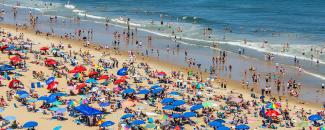
Planning the ideal trip to the coast doesn't require dipping a single toe into the water to test the temperature. NCEI’s Coastal Water Temperature Guide (CWTG) does all the hard work for water enthusiasts looking for special destinations.
The CWTG provides an easy-to-use interactive map with recent ocean and Great Lakes temperatures. This temperature data is regularly updated from buoys, tide gauges, and other monitoring stations from NOAA’s National Data Buoy Center and NOAA’s Center for Operational Oceanographic Products and Services. In addition, the map has a daily, optimally interpolated sea surface temperature satellite image which fills in the water temperature gaps between physical stations.
Swimmers, boaters, surfers, beach-goers, and anglers all use the guide for various reasons. Usage increases during times of hurricane activity due to the effect that ocean temperatures have on hurricane strength. Scientists can use it for invasive species determination or hypothermia estimates, as well.
Value of the Coastal Water Temperature Guide
The CWTG utilizes an Esri-based GIS map to create an intuitive format for accessing data from about 300 stations across the United States and its territories. These stations allow the user to compare the area’s current ocean temperature to past averages and to view other information collected by each station. In addition to water temperature, you can click through to the stations, which collect data on water levels, air temperature and pressure, wave heights, and wind speed.
The addition of a sea surface temperature image map layer fills in the water temperature gaps between physical stations.
The CWTG also enables users to see the effects of short-term influences on ocean temperatures. Certain events can influence the temperature of coastal waters, such as upwelling—when colder deep water rises due to persistent wind conditions pushing warmer surface water away from the coast. Additionally, other changes in weather and river runoff may affect ocean temperatures. A feature that makes it stand out from its many uses of real-time water temperatures are the calculated monthly means, which allows users to plan recreational or vacation decisions in advance.
Using the Coastal Water Temperature Guide
Each pin on the map represents a buoy or tide gauge station. Users can click on a station and bring up a popup window that displays the near real-time temperature, a monthly mean temperature, as well as a link to the station’s webpage. Further data collected at each station, such as air temperature, wind speed, water levels, and in some cases, wave data, can be found on the station’s webpage.
Clicking on the sea surface temperature layer reveals a daily climatology temperature calculated by NCEI's Surface Marine in-situ group using data from satellites, ships, buoys, and Argo floats.
If you do not wish to use the map version, a table of all locations is also available. The table includes near real-time water temperature and monthly averages



